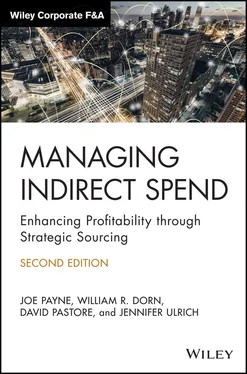1 ...6 7 8 10 11 12 ...20 When ranking categories, you are essentially determining the order in which you plan to drill down further into the data. Factors to consider when developing your ranking include how much spend is included within a category, how many suppliers are included with in a category, which categories have not been sourced recently, and which categories can be sourced most quickly (and with the least resistance). Understanding your company culture is important for properly managing this step. For example, depending on the industry you serve, the Marketing category will probably be high up your list in terms of both spend and suppliers utilized. However, many Marketing departments rely on close relationships with their suppliers and maintain tight control over their supplier selection process. This may cause them to be very reluctant to work with people outside of the Marketing department on supplier selection or supplier negotiations. If you are unfamiliar with sourcing and purchasing in the Marketing category (or you get the impression that there is high resistance from Marketing), you may not want to identify this area as a starting point. Instead, focus on areas of the organization that are more open to change or are less politically sensitive.
This is not to say that Marketing spend should not be examined. The purpose of a Strategic Sourcing initiative is to reduce costs and hopefully create significant savings opportunities in the area of Marketing. However, building sponsorship and buy‐in to the process is critical, and sometimes the best way to do that is by showing some positive results from previous initiative. Starting with a department that is reluctant to engage will not help you build that business case.
Now that you have ranked the categories, it is time to subcategorize the information into projects. During this stage, you are identifying what you consider to be distinct Strategic Sourcing initiatives, each with its own project plan, timeline, and sourcing strategy. In doing this, you are developing a preliminary sourcing strategy based on leverage points—grouping the spend in a way that provides the best opportunity for a supplier to reduce price, improve service levels, or provide additional incentives.
At this stage, you probably won't have a clear understanding of price points, a full understanding of the supply base (capacity issues, regional variances, service differentiators, etc.), or other aspects that could create leverage; all you know is spend by supplier and category.
Start with the categories that you have ranked the highest. Review the suppliers in the category and determine the types of products or services they provide. Ask yourself the following questions:
Are there other suppliers in the category that provide the same or similar products or services?
Is there overlap between what is being supplied in this category and another category?
Can I include spend from two different suppliers in the same bid?
The easiest way to answer these questions is to think about the suppliers that you would want to participate in the bid process. When thinking about administrative supplies, you may want to invite Staples to a bid for paper, but you probably would not invite Xerox to a bid for other office supplies. So your subcategory now becomes Office Supplies. Down the road you might find it necessary to segment paper into its own bid, or you might decide to allow Xerox to participate in the paper portion of the office supplies bid, but it is not necessary to make that decision at this time. Conversely, you might know that Konica Minolta sells your company copiers and printers, which Staples or most other suppliers of office supplies (or paper products) do not. Therefore, your subcategory for Konica Minolta would be either copiers or office equipment.
Now that your subcategories are laid out, run a new pivot table to determine which subcategories have the greatest spend and number of suppliers. This should be similar to when you initially categorized the data. Now, rank your subcategories (or projects) based on the order in which you want to source them, remembering that you want to tackle quick‐win projects first to demonstrate the success of your initiative. You now have a preliminary sourcing road map with a list of potential projects. An example of a simple project road map is provided in Table 2.4.
TABLE 2.4Project Road Map
| Project |
Total Spend |
Total Suppliers |
Ranking |
| Elevator maintenance |
$1,421,000 |
1 |
1 |
| Office supplies |
$1,256,689 |
2 |
1 |
| Shipping and postage |
$1,241,480 |
3 |
1 |
| Maintenance supplies |
$ 588,157 |
2 |
1 |
| Copiers and paper |
$ 311,189 |
1 |
1 |
| Printing |
$1,084,767 |
2 |
2 |
| Garbage disposal |
$ 908,312 |
1 |
2 |
| HVAC services |
$ 896,586 |
2 |
2 |
| Advertising |
$2,170,000 |
1 |
3 |
| Plumbing services |
$ 320,276 |
1 |
3 |
| Janitorial services |
$ 200,555 |
1 |
3 |
| Graphic design |
$ 270,312 |
1 |
4 |
| Market research |
$ 62,123 |
1 |
4 |
Previously in this chapter, we briefly discussed toolsets that assist companies in the spend analysis process. The market offers many such toolsets, but a detailed discussion of the merits and differences of each is beyond the scope of this book. Websites such as Spend Matters or Sourcing Innovation and research firms such as Gartner, AMR, and Forrester can provide detailed insights into the toolset best suited to your organization.
On their simplest level, spend analysis tools automate the process detailed earlier in this chapter. Data are uploaded into the tool, and information is cleansed and categorized based on criteria developed by the toolset provider. You can also develop customized rules based on your industry, the types of data being entered, and the type of analysis you want to see.
Besides saving a lot of time that would have been spent manually cleansing and categorizing data, these toolsets provide several other advantages.
First, spend analysis tools can be used over and over again on new data as you continue to make purchases. Once you have established that a supplier should be named and categorized a certain way, you can rerun reports with real‐time data. The manual process is based on data from a specific time and, subsequently, can become stagnant or outdated.
Another key advantage to spend analysis is the types of reporting you can get from the data throughout the initiative. In Chapter 8, we discuss monitoring implemented programs and methodologies to track success. Spend analysis tools can provide these tracking mechanisms and even help report savings produced through.
Depending on the amount of data and the goals of your initiative, you may want to consider utilizing a toolset during the spend analysis phase of the project.
We provide more information about spend analysis tools and their benefits in Chapters 11and 16.
One stage of Strategic Sourcing initiatives that is often overlooked is the project kickoff. Regardless of your role within the organization, it is important to make sure that you are not operating in isolation. Others should develop an understanding of the goals and objectives of your initiative.
The executive team should be aware of your initiative and offer their support to see it through. The reason is simple: change does not always come easy. Over time, you will find that the biggest roadblock to achieving savings is not the supply base. Suppliers rarely offer the best price possible. As such, they're always inadvertently paving the way to savings. In many cases, the greatest impediment turns out to be implementing change within your organization. All too often, Procurement or Finance teams uncover an opportunity to reduce costs substantially and, naturally, believe that the facts will speak for themselves. They come to realize, however, that it takes much more effort and convincing than they initially thought. Even with the best business case, you will find that having the support of the executive team or other higher‐ups within the organization pays off.
Читать дальше












